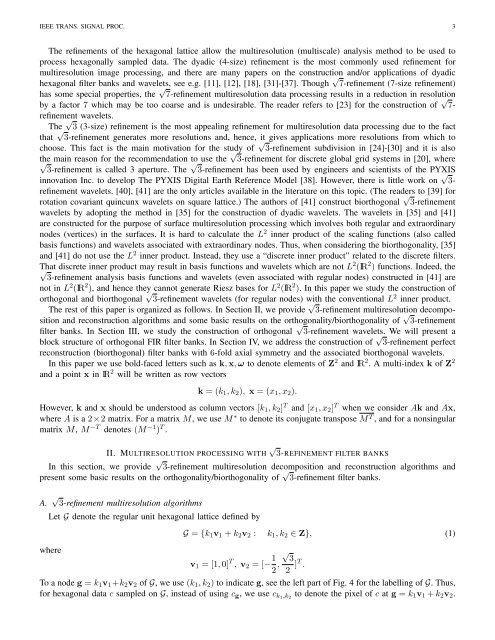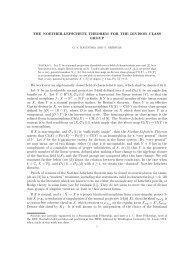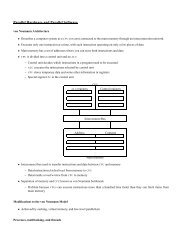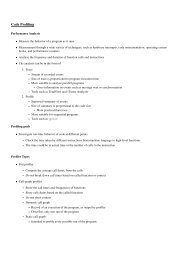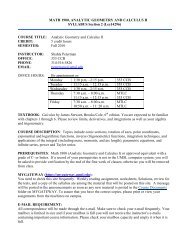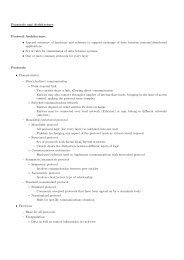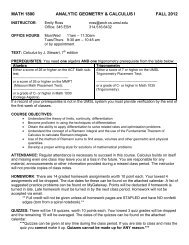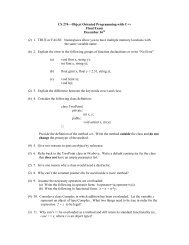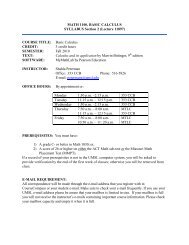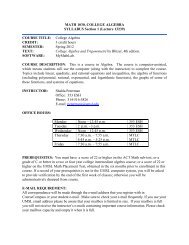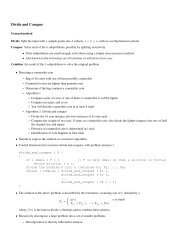here - UMSL : Mathematics and Computer Science - University of ...
here - UMSL : Mathematics and Computer Science - University of ...
here - UMSL : Mathematics and Computer Science - University of ...
You also want an ePaper? Increase the reach of your titles
YUMPU automatically turns print PDFs into web optimized ePapers that Google loves.
IEEE TRANS. SIGNAL PROC. 3<br />
The refinements <strong>of</strong> the hexagonal lattice allow the multiresolution (multiscale) analysis method to be used to<br />
process hexagonally sampled data. The dyadic (4-size) refinement is the most commonly used refinement for<br />
multiresolution image processing, <strong>and</strong> t<strong>here</strong> are many papers on the construction <strong>and</strong>/or applications <strong>of</strong> dyadic<br />
hexagonal filter banks <strong>and</strong> wavelets, see e.g. [11], [12], [18], [31]-[37]. Though √ 7-refinement (7-size refinement)<br />
has some special properties, the √ 7-refinement multiresolution data processing results in a reduction in resolution<br />
by a factor 7 which may be too coarse <strong>and</strong> is undesirable. The reader refers to [23] for the construction <strong>of</strong> √ 7-<br />
refinement wavelets.<br />
The √ 3 (3-size) refinement is the most appealing refinement for multiresolution data processing due to the fact<br />
that √ 3-refinement generates more resolutions <strong>and</strong>, hence, it gives applications more resolutions from which to<br />
choose. This fact is the main motivation for the study <strong>of</strong> √ 3-refinement subdivision in [24]-[30] <strong>and</strong> it is also<br />
the main reason for the recommendation to use the √ 3-refinement for discrete global grid systems in [20], w<strong>here</strong><br />
√<br />
3-refinement is called 3 aperture. The<br />
√<br />
3-refinement has been used by engineers <strong>and</strong> scientists <strong>of</strong> the PYXIS<br />
innovation Inc. to develop The PYXIS Digital Earth Reference Model [38]. However, t<strong>here</strong> is little work on √ 3-<br />
refinement wavelets. [40], [41] are the only articles available in the literature on this topic. (The readers to [39] for<br />
rotation covariant quincunx wavelets on square lattice.) The authors <strong>of</strong> [41] construct biorthogonal √ 3-refinement<br />
wavelets by adopting the method in [35] for the construction <strong>of</strong> dyadic wavelets. The wavelets in [35] <strong>and</strong> [41]<br />
are constructed for the purpose <strong>of</strong> surface multiresolution processing which involves both regular <strong>and</strong> extraordinary<br />
nodes (vertices) in the surfaces. It is hard to calculate the L 2 inner product <strong>of</strong> the scaling functions (also called<br />
basis functions) <strong>and</strong> wavelets associated with extraordinary nodes. Thus, when considering the biorthogonality, [35]<br />
<strong>and</strong> [41] do not use the L 2 inner product. Instead, they use a “discrete inner product” related to the discrete filters.<br />
That discrete inner product may result in basis functions <strong>and</strong> wavelets which are not L 2 (IR 2 ) functions. Indeed, the<br />
√<br />
3-refinement analysis basis functions <strong>and</strong> wavelets (even associated with regular nodes) constructed in [41] are<br />
not in L 2 (IR 2 ), <strong>and</strong> hence they cannot generate Riesz bases for L 2 (IR 2 ). In this paper we study the construction <strong>of</strong><br />
orthogonal <strong>and</strong> biorthogonal √ 3-refinement wavelets (for regular nodes) with the conventional L 2 inner product.<br />
The rest <strong>of</strong> this paper is organized as follows. In Section II, we provide √ 3-refinement multiresolution decomposition<br />
<strong>and</strong> reconstruction algorithms <strong>and</strong> some basic results on the orthogonality/biorthogonality <strong>of</strong> √ 3-refinement<br />
filter banks. In Section III, we study the construction <strong>of</strong> orthogonal √ 3-refinement wavelets. We will present a<br />
block structure <strong>of</strong> orthogonal FIR filter banks. In Section IV, we address the construction <strong>of</strong> √ 3-refinement perfect<br />
reconstruction (biorthogonal) filter banks with 6-fold axial symmetry <strong>and</strong> the associated biorthogonal wavelets.<br />
In this paper we use bold-faced letters such as k, x, ω to denote elements <strong>of</strong> Z 2 <strong>and</strong> IR 2 . A multi-index k <strong>of</strong> Z 2<br />
<strong>and</strong> a point x in IR 2 will be written as row vectors<br />
k = (k 1 , k 2 ), x = (x 1 , x 2 ).<br />
However, k <strong>and</strong> x should be understood as column vectors [k 1 , k 2 ] T <strong>and</strong> [x 1 , x 2 ] T when we consider Ak <strong>and</strong> Ax,<br />
w<strong>here</strong> A is a 2×2 matrix. For a matrix M, we use M ∗ to denote its conjugate transpose M T , <strong>and</strong> for a nonsingular<br />
matrix M, M −T denotes (M −1 ) T .<br />
II. MULTIRESOLUTION PROCESSING WITH<br />
√<br />
3-REFINEMENT FILTER BANKS<br />
In this section, we provide √ 3-refinement multiresolution decomposition <strong>and</strong> reconstruction algorithms <strong>and</strong><br />
present some basic results on the orthogonality/biorthogonality <strong>of</strong> √ 3-refinement filter banks.<br />
A. √ 3-refinement multiresolution algorithms<br />
Let G denote the regular unit hexagonal lattice defined by<br />
w<strong>here</strong><br />
G = {k 1 v 1 + k 2 v 2 : k 1 , k 2 ∈ Z}, (1)<br />
v 1 = [1, 0] T , v 2 = [− 1 2 , √<br />
3<br />
2 ]T .<br />
To a node g = k 1 v 1 +k 2 v 2 <strong>of</strong> G, we use (k 1 , k 2 ) to indicate g, see the left part <strong>of</strong> Fig. 4 for the labelling <strong>of</strong> G. Thus,<br />
for hexagonal data c sampled on G, instead <strong>of</strong> using c g , we use c k1 ,k 2<br />
to denote the pixel <strong>of</strong> c at g = k 1 v 1 + k 2 v 2 .


